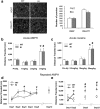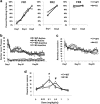MeCP2 phosphorylation limits psychostimulant-induced behavioral and neuronal plasticity
- PMID: 24671997
- PMCID: PMC3965780
- DOI: 10.1523/JNEUROSCI.2821-13.2014
MeCP2 phosphorylation limits psychostimulant-induced behavioral and neuronal plasticity
Abstract
The methyl-DNA binding protein MeCP2 is emerging as an important regulator of drug reinforcement processes. Psychostimulants induce phosphorylation of MeCP2 at Ser421; however, the functional significance of this posttranslational modification for addictive-like behaviors was unknown. Here we show that MeCP2 Ser421Ala knock-in mice display both a reduced threshold for the induction of locomotor sensitization by investigator-administered amphetamine and enhanced behavioral sensitivity to the reinforcing properties of self-administered cocaine. These behavioral differences were accompanied in the knock-in mice by changes in medium spiny neuron intrinsic excitability and nucleus accumbens gene expression typically observed in association with repeated exposure to these drugs. These data show that phosphorylation of MeCP2 at Ser421 functions to limit the circuit plasticities in the nucleus accumbens that underlie addictive-like behaviors.
Keywords: GABAergic interneurons; MeCP2; cocaine self-administration; intrinsic excitability; nucleus accumbens; psychostimulants.
Figures






References
-
- Chao HT, Chen H, Samaco RC, Xue M, Chahrour M, Yoo J, Neul JL, Gong S, Lu HC, Heintz N, Ekker M, Rubenstein JL, Noebels JL, Rosenmund C, Zoghbi HY. Dysfunction in GABA signalling mediates autism-like stereotypies and Rett syndrome phenotypes. Nature. 2010;468:263–269. doi: 10.1038/nature09582. - DOI - PMC - PubMed
-
- Cohen S, Gabel HW, Hemberg M, Hutchinson AN, Sadacca LA, Ebert DH, Harmin DA, Greenberg RS, Verdine VK, Zhou Z, Wetsel WC, West AE, Greenberg ME. Genome-wide activity-dependent MeCP2 phosphorylation regulates nervous system development and function. Neuron. 2011;72:72–85. doi: 10.1016/j.neuron.2011.08.022. - DOI - PMC - PubMed
Publication types
MeSH terms
Substances
Grants and funding
LinkOut - more resources
Full Text Sources
Other Literature Sources
Molecular Biology Databases
